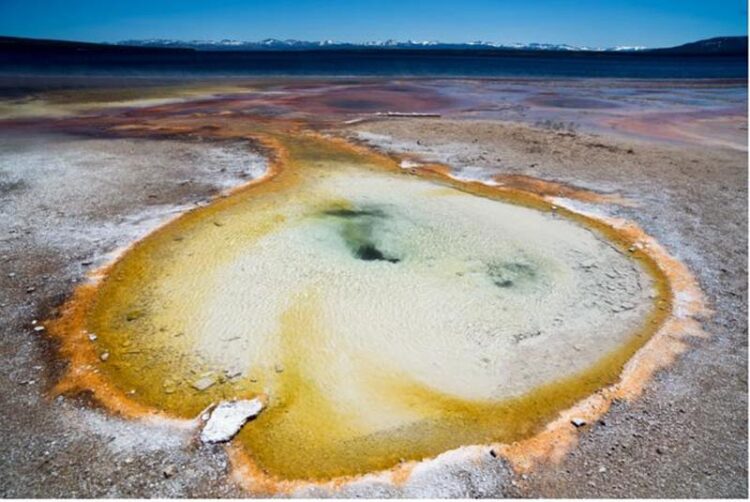Life in boiling water

Scientists conducted microbial DNA sampling at a Yellowstone National Park hot spring for a study sponsored by DOE’s Biological and Environmental Research program, the National Science Foundation and NASA.
Credit: Mircea Podar/ORNL, U.S. Dept. of Energy
Scientists find evolutionary clues while examining microbes in far-flung hot springs.
Oak Ridge National Laboratory scientists studied hot springs on different continents and found similarities in how some microbes adapted despite their geographic diversity. The findings yield clues to the evolution of life and whether some of the hardiest microbes may be harnessed for biotechnology.
The study was the first of its kind to sample hot springs on three continents with water temperatures above 65 C (149 F) in the United States, Iceland and Japan.
The environments have unique geology and chemistry, almost like a fingerprint, so it was surprising to find highly related microbes separated by thousands of miles, said ORNL’s Mircea Podar, co-lead of the study with researchers at Montana State University.
“We found common microbes, but also diversity as the microorganisms adapted to local conditions,” Podar said. The scientists theorize that tectonic conditions and geology of the hot springs are at play, providing new insights into how life and the Earth have co-evolved. —Stephanie Seay
Journal: Environmental Microbiology
DOI: 10.1111/1462-2920.16472
Article Title: Tectonic and geological setting influence hot spring microbiology
Article Publication Date: 8-Aug-2023
Media Contact
Kim Askey
DOE/Oak Ridge National Laboratory
askeyka@ornl.gov
Office: 865-576-2841
Original Source
All latest news from the category: Life Sciences and Chemistry
Articles and reports from the Life Sciences and chemistry area deal with applied and basic research into modern biology, chemistry and human medicine.
Valuable information can be found on a range of life sciences fields including bacteriology, biochemistry, bionics, bioinformatics, biophysics, biotechnology, genetics, geobotany, human biology, marine biology, microbiology, molecular biology, cellular biology, zoology, bioinorganic chemistry, microchemistry and environmental chemistry.
Newest articles

Compact LCOS Microdisplay with Fast CMOS Backplane
…for High-Speed Light Modulation. Researchers from the Fraunhofer Institute for Photonic Microsystems IPMS, in collaboration with HOLOEYE Photonics AG, have developed a compact LCOS microdisplay with high refresh rates that…

New perspectives for material detection
CRC MARIE enters third funding period: A major success for terahertz research: Scientists at the University of Duisburg-Essen and the Ruhr University Bochum have been researching mobile material detection since…

CD Laboratory at TU Graz Researches New Semiconductor Materials
Using energy- and resource-saving methods, a research team at the Institute of Inorganic Chemistry at TU Graz aims to produce high-quality doped silicon layers for the electronics and solar industries….



